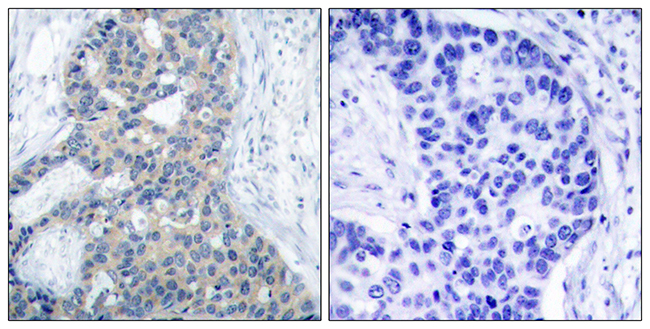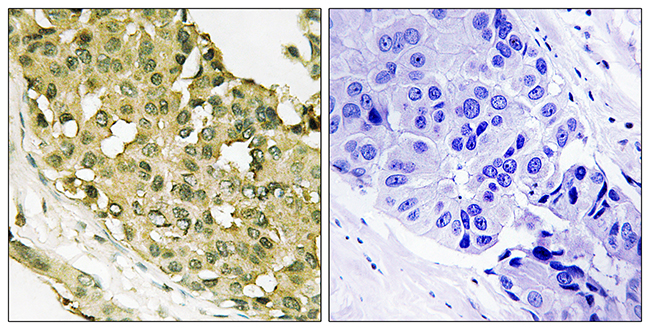c-Myc-Mediated Epigenetic Silencing of MicroRNA-101 Contributes to Dysregulation of Multiple Pathways in Hepatocellular Carcinoma
HEPATOLOGY
Authors: Wang, Lei; Zhang, Xiang; Jia, Lin-Tao; Hu, Si-Jun; Zhao, Jing; Yang, Jian-Dong; Wen, Wei-Hong; Wang, Zhe; Wang, Tao; Zhao, Jun; Wang, Rui-An; Meng, Yan-Ling; Nie, Yong-Zhan; Dou, Ke-Feng; Chen, Si-Yi; Yao, Li-Bo; Fan, Dai-Ming; Zhang, Rui; Yang, An-Gang
Abstract
The MYC oncogene is overexpressed in hepatocellular carcinoma (HCC) and has been associated with widespread microRNA (miRNA) repression; however, the underlying mechanisms are largely unknown. Here, we report that the c-Myc oncogenic transcription factor physically interacts with enhancer of zeste homolog 2 (EZH2), a core enzymatic unit of polycomb repressive complex 2 (PRC2). Furthermore, miR-101, an important tumor-suppressive miRNA in human hepatocarcinomas, is epigenetically repressed by PRC2 complex in a c-Myc-mediated manner. miR-101, in turn, inhibits the expression of two subunits of PRC2 (EZH2 and EED), thus creating a double-negative feedback loop that regulates the process of hepatocarcinogenesis. Restoration of miR-101 expression suppresses multiple malignant phenotypes of HCC cells by coordinate repression of a cohort of oncogenes, including STMN1, JUNB, and CXCR7, and further increases expression of endogenous miR-101 by inhibition of PRC2 activation. In addition, co-overexpression of c-Myc and EZH2 in HCC samples was closely associated with lower expression of miR-101 (P < 0.0001) and poorer prognosis of HCC patients (P < 0.01). Conclusions: c-Myc collaborates with EZH2-containing PRC2 complex in silencing tumor-suppressive miRNAs during hepatocarcinogenesis and provides promising therapeutic candidates for human HCC. (Hepatology 2014;59:1850-1863)
Association of STMN1 with survival in solid tumors: A systematic review and meta-analysis
INTERNATIONAL JOURNAL OF BIOLOGICAL MARKERS
Authors: Zhang, Dan; Dai, Lizhen; Yang, ZengXi; Wang, XiChen; Yin LanNing
Abstract
Background: The prognostic value of Stathmin 1 (STMN1) in malignant solid tumors remains controversial. Thus, we conducted this meta-analysis to summarize the potential value of STMN1 as a biomarker for predicting overall survival in patients with solid tumor. Methods: We systematically searched eligible studies in PubMed, Web of Science, and EMBASE from the establishment date of these databases to September 2018. Hazard ratio (HR) and its 95% confidence interval (CI) was used to assess the association between STMN1 expression and overall survival. Results: A total of 25 studies with 4625 patients were included in this meta-analysis. Our combined results showed that high STMN1 expression was associated with poor overall survival in solid tumors (HR = 1.85, 95% CI 1.55, 2.21). In general, our subgroup and sensitivity analyses demonstrated that our combined results were stable and reliable. However, from the results of the subgroups we found that high STMN1 expression was not related to overall survival in colorectal cancer and endometrial cancer anymore, suggesting that much caution should be taken to interpret our combined result, and more studies with large sample sizes are required to further explore the prognostic value of STMN1 expression in the specific type of tumors, especially colorectal cancer and endometrial cancer. Conclusions: STMN1 could serve as a prognostic biomarker and could be developed as a valuable therapeutic target for patients with solid tumors. However, due to the limitations of the present meta-analysis, this conclusion should be taken with caution. Further studies adequately designed are required to confirm our findings.
![]()


